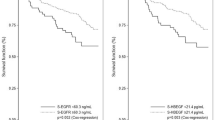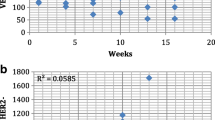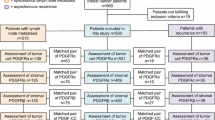Abstract
A cross talk between tyrosine kinase receptors and mitogen-activated protein kinases (MAPKs) is proposed as involved in endocrine resistance. We wanted to investigate intratumoral levels of vascular endothelial growth factor receptor 2 (VEGFR2) and p38 MAPK in relation to relapse-free (RFS) and breast cancer corrected survival (BCCS) after adjuvant endocrine treatment, mainly tamoxifen for 2 or 5 years. We also wanted to investigate these markers in relation to early and late recurrences. VEGFR2 (n = 381) and p38 (n = 174) were determined by enzyme-linked immuno-sorbent assays in tumor homogenates from primary BC diagnosed 1993–1996. Wide ranges of VEGFR2 and p38 proteins were found; median 0.72 pg/μg DNA (range 0.0–11.66), and 0.04 pg/μg DNA (range 0.0–6.79), respectively. Detectable levels of p38 were registered in 65% and classified positive. Higher VEGFR2 were correlated to higher VEGF (P = 0.005), p38 MAPK (P = 0.018), negative ER (P = 0.008), larger tumors (P = 0.001), histopathological grade III (P = 0.018), distant metastasis (P = 0.044), shorter RFS (P = 0.013), and shorter BCCS (P = 0.017). Expression of p38 was significantly correlated with negative PgR (P = 0.044) and with early relapses (P = 0.021), while no difference was seen during the later follow-up period (P = 0.73). Higher VEGFR2 had a significant negative impact on both early (P = 0.029) and later recurrences (P = 0.018), while VEGF only predicted later relapses (P = 0.037). Our preliminary results suggest higher intratumoral levels of VEGFR2 and p38 MAPK as candidate markers of intrinsic resistance for adjuvant endocrine therapy.



Similar content being viewed by others
References
Hanahan D, Weinberg R (2000) The hallmarks of cancer. Cell 100:57–70
Guo P, Fang Q, Tao HQ, Schafer CA, Fenton BM, Ding I, Hu B, Cheng SY (2003) Overexpression of vascular endothelial growth factor by MCF-7 breast cancer cells promotes estrogen-independent tumor growth in vivo. Cancer Res 63:4684–4691
Kroll J, Waltenberger J (1999) A novel function of VEGF receptor-2 (KDR): rapid release of nitric oxide in response to VEGF-A stimulation in endothelial cells. Biochem Biophys Res Commun 265:636–639
Aesoy R, Sanchez BC, Norum JH, Lewensohn R, Viktorsson K, Linderholm B (2008) An autocrine VEGF/VEGFR2 and p38 signaling loop confers resistance to 4-hydroxytamoxifen in MCF-7 breast cancer cells. Mol Cancer Res 10:1630–1638
Folkman J (2003) Fundamental concepts of the angiogenic process. Curr Mol Med 3:643–651 Review
Garrington TP, Johnson GL (1999) Organization and regulation of mitogen-activated protein kinase signaling pathways. Curr Opin Cell Biol 11:211–218 Review
Fanger GR (1999) Regulation of the MAPK family members: role of subcellular localization and architectural organization. Histol Histopathol 14:887–894 Review
Kyriakis JM, Avruch J (2001) Mammalian Mitogen-activated protein kinase signal transduction pathways activated by stress and inflammation. Physiol Rev 81:807–869
Rutqvist LE, Cedermark B, Fornander T, Glas U, Johansson H, Nordenskjöld B, Rotstein S, Skoog L, Somell A, Theve T et al (1989) The relationship between hormone receptor content and the effect of adjuvant tamoxifen in operable breast cancer. J Clin Oncol 7(10):1474–1484
Cornier EM, Wolf MF, Jordan VC (1989) Decrease in estradiol-stimulated progesterone receptor production in MCF-7 cells by epidermal growth factor and possible clinical implication for paracrine-regulated breast cancer growth. Cancer Res 49:576–580
Cui X, Zhang P, Deng W, Oesterreich S, Lu Y, Mills GB, Lee AV (2003) Insulin-like growth factor-I inhibits progesterone receptor expression in breast cancer cells via the phosphatidylinositol 3-kinase/Akt/mammalian target of rapamycin pathway: progesterone receptor as a potential indicator of growth factor activity in breast cancer. Mol Endocrinol 17:575–588
Osipo C, Gajdos C, Cheng D, Jordan VC (2005) Reversal of tamoxifen resistant breast cancer by low dose estrogen therapy. J Steroid Biochem Mol Biol 93:249–256
Osborne CK, Pippen J, Jones SE, Parker LM, Ellis M, Come S, Gertler SZ, May JT, Burton G, Dimery I, Webster A, Morris C, Elledge R, Buzdar A (2002) Double-blind, randomized trial comparing the efficacy and tolerability of fulvestrant versus anastrozole in postmenopausal women with advanced breast cancer progressing on prior endocrine therapy: results of a North American trial. J Clin Oncol 20:3386–3395
Howell A, Robertson JF, Quaresma Albano J, Aschermannova A, Mauriac L, Kleeberg UR, Vergote I, Erikstein B, Webster A, Morris C (2002) Fulvestrant, formerly ICI 182, 780, is as effective as anastrozole in postmenopausal women with advanced breast cancer progressing after prior endocrine treatment. J Clin Oncol 20:3396–3403
Linderholm B, Bergqvist J, Hellborg H, Johansson U, Linderholm M, von Schoultz E, Elmberger G, Skoog L, Bergh J (2009) Shorter survival times following adjuvant endocrine therapy in oestrogen (ER)—and progesterone receptor (PgR) positive breast cancer (BC) overexpressing HER2 and/or with an increased expression of vascular endothelial growth factor (VEGF). Med Oncol 26:480–490
Linderholm BK, Hellborg H, Johansson U, Elmberger E, Skoog L, Lehtiö J, Lewensohn R (2009) Significantly higher levels of vascular endothelial growth factor (VEGF) and shorter survival times for patients with primary operable triple negative breast cancer. Ann Oncol 20:1639–1646
Geurts-Moespot J, Leake R, Benraad TJ, Sweep CG (2000) Twenty years of experience with the steroid receptor external quality assessment program—the paradigm for tumour biomarker EQA studies. On behalf of the EORTC Receptor and Biomarker Study Group. Int J Oncol 17:13–22 Review
Linderholm B, Tavelin B, Grankvist K, Henriksson R (1998) Vascular endothelial growth factor is of high prognostic value in node-negative breast carcinoma. J Clin Oncol 16:3121–3131
Linderholm B, Grankvist K, Wilking N, Johansson M, Tavelin B, Henriksson R (2000) Correlation of Vascular Endothelial Growth Factor (VEGF) and survival, metastasis sites and responsiveness to adjuvant systemic treatment in primary node-positive breast carcinoma. J Clin Oncol 18:1423–1431
Foekens JA, Peters HA, Grebenchtchikov N, Look MP, Meijer-van Gelder ME, Geurts-Moespot A et al (2001) High tumor levels of vascular endothelial growth factor predict poor response to systemic therapy in advanced breast cancer. Cancer Res 61:5407–5414
Manders P, Beex LV, Tjan-Heijnen VC, Span PN, Sweep CG (2003) Vascular endothelial growth factor is associated with the efficacy of endocrine therapy in patients with advanced breast carcinoma. Cancer 98:2125–2132
McShane LM, Altman DG, Sauerbrei W, Taube SE, Gion M, Clark GM, Statistics Subcommittee of the NCI-EORTC Working Group on Cancer Diagnostics (2005) Reporting recommendations for tumor marker prognostic studies. J Clin Oncol 23:9067–9072
Poon RT, Fan ST, Wong J (2001) Clinical implications of circulating angiogenic factors in cancer patients. J Clin Oncol 19:1207–1225
Rydén L, Jirström K, Bendahl PO, Fernö M, Nordenskjöld B, Stål O, Thorstenson S, Jönsson PE, Landberg G (2005) Tumor-specific expression of vascular endothelial growth factor receptor 2 but not vascular endothelial growth factor or human epidermal growth factor receptor 2 is associated with impaired response to adjuvant tamoxifen in premenopausal breast cancer. J Clin Oncol 23:4695–4704
Rydén L, Stendahl M, Jonsson H, Emdin S, Bengtsson NO, Landberg G (2005) Tumor-specific VEGF-A and VEGFR2 in postmenopausal breast cancer patients with long-term follow-up. Implication of a link between VEGF pathway and tamoxifen response. Breast Cancer Res Treat 89:135–143
Guarneri V, Piacentini F, Ficarra G, Frassoldati A, D’Amico R, Giovannelli S, Maiorana A, Jovic G, Conte P (2009) A prognostic model based on nodal status and Ki-67 predicts the risk of recurrence and death in breast cancer patients with residual disease after preoperative chemotherapy. Ann Oncol 20:1193–1198
Johnston SR, Saccani-Jotti G, Smith IE, Salter J, Newby J, Coppen M, Ebbs SR, Dowsett M (1995) Changes in estrogen receptor, progesterone receptor, and pS2 expression in tamoxifen-resistant human breast cancer. Cancer Res 55:3331–3338
Knowlden JM, Hutcheson IR, Jones HE, Madden T, Gee JM, Harper ME, Barrow D, Wakeling AE, Nicholson RI (2003) Elevated levels of epidermal growth factor receptor/c-erbB2 heterodimers mediate an autocrine growth regulatory pathway in tamoxifen-resistant MCF-7 cells. Endocrinology 144:1032–1044
Bunone G, Briand PA, Miksicek RJ, Picard D (1996) Activation of the unliganded estrogen receptor by EGF involves the MAP kinase pathway and direct phosphorylation. EMBO J 15:2174–2183
Lee H, Bai W (2002) Regulation of estrogen receptor nuclear export by ligand-induced and p38-mediated receptor phosphorylation. Mol Cell Biol 22:5835–5845
Gutierrez MC, Detre S, Johnston S, Mohsin SK, Shou J, Allred DC, Schiff R, Osborne CK, Dowsett M (2005) Molecular changes in tamoxifen-resistant breast cancer: relationship between estrogen receptor, HER-2, and p38 mitogen-activated protein kinase. J Clin Oncol 23:2469–2476
Svensson S, Jirström K, Rydén L, Roos G, Emdin S, Ostrowski MC, Landberg G (2005) ERK phosphorylation is linked to VEGFR2 expression and Ets-2 phosphorylation in breast cancer and is associated with tamoxifen treatment resistance and small tumours with good prognosis. Oncogene 24:4370–4379
Bergqvist J, Elmberger G, Odh J, Linderholm B, Bjohle J, Hellborg H, Nordgren H, Borg AL, Skoog L, Bergh J (2006) Activated ERK1/2 and phosphorylated oestrogen receptor alpha are associated with improved breast cancer survival in women treated with tamoxifen. Eur J Cancer 42:1104–1112
Qi X, Pohl NM, Loesch M, Hou S, Li R, Qin JZ, Cuenda A, Chen G (2007) p38alpha antagonizes p38gamma activity through c-Jun-dependent ubiquitin-proteasome pathways in regulating Ras transformation and stress response. J Biol Chem 282:31398–31408
Acknowledgments
This study was supported by grants from the Swedish Research Council (K2008-54X-20639-01-3), the Swedish State under the LUA-agreement (Sahlgrenska University Hospital, Gothenburg) (VGFOUREG-75911), the King Gustav V Jubilee Clinic Cancer Research Foundation, Gothenburg (2009:49), and the Gösta Milton Foundation, Stockholm, Sweden.
Conflict of interest
None of the authors have any conflict of interest that can be perceived as prejudicing the impartiality of the research reported.
Author information
Authors and Affiliations
Corresponding author
Rights and permissions
About this article
Cite this article
Linderholm, B.K., Hellborg, H., Johansson, U. et al. Vascular endothelial growth factor receptor 2 and downstream p38 mitogen-activated protein kinase are possible candidate markers of intrinsic resistance to adjuvant endocrine treatment in steroid receptor positive breast cancer. Breast Cancer Res Treat 125, 457–465 (2011). https://doi.org/10.1007/s10549-010-1252-x
Received:
Accepted:
Published:
Issue Date:
DOI: https://doi.org/10.1007/s10549-010-1252-x




